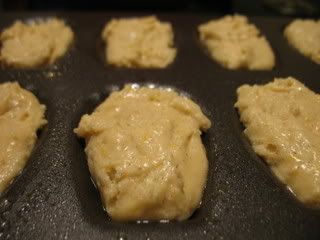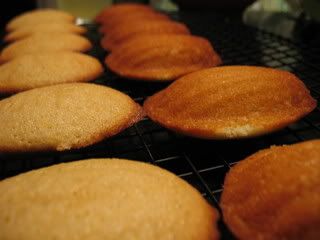Mmmm....madeleines....freshly baked vanilla & lemon cakes, still a bit warm from the oven, are delicious with a glass of chilled French rose wine.
I was so excited about this making this recipe. You see, I had already decided that when it was my turn to choose a recipe, that I would pick madeleines. I'd been wanting to make them for a while, and I was thrilled that I had an excuse to do so...and to buy that adorable pan!
Overall, I was surprised at how easy this recipe is. Just mix the batter, let it chill a few hours (or overnight), then fill the molds & bake! The recipe makes 12 little cakes, the number of molds in the pan. So, you don't have tons of dessert (or extra batter) left over to pawn off on everyone you know. They are, as Dorie mentions at the end of the recipe, best eaten soon after they are baked. However, they aren't too shabby the next day dunked into a cup of hot Earl Grey.
Traditional Madeleines
 Madeleines are among the most recognizable pastries in the French repertoire because of their look: they are made in scallop-shaped molds from which they emerge ridged on one side, plump and full-bellied on the other and golden. That they are among the best known is thanks to Marcel Proust, who immortalized them in his novel Remembrance of Things Past. Everyone seems to know the story of Proust's narrator dipping the cookie into his tea and having the first taste bring back a flood of childhood memories. With that short entry, Proust and the madeleine gained such celebrity that even people who've never tasted the cookie refer to it with confidence as a touchstone. Yet when you take away all the literary allusions and all the romance, what you're left with is a tea cake that deserves to be famous for its deliciousness alone.
Madeleines are among the most recognizable pastries in the French repertoire because of their look: they are made in scallop-shaped molds from which they emerge ridged on one side, plump and full-bellied on the other and golden. That they are among the best known is thanks to Marcel Proust, who immortalized them in his novel Remembrance of Things Past. Everyone seems to know the story of Proust's narrator dipping the cookie into his tea and having the first taste bring back a flood of childhood memories. With that short entry, Proust and the madeleine gained such celebrity that even people who've never tasted the cookie refer to it with confidence as a touchstone. Yet when you take away all the literary allusions and all the romance, what you're left with is a tea cake that deserves to be famous for its deliciousness alone.
The madeleine is a beautiful, if somewhat plain, cookie made from the kind of batter you'd use for a sponge cake. What distinguishes it is its lightness; its texture—the tiny-bubbled crumb is très raffiné; and its flavor, a delicate mix of lemon, vanilla and butter.
This recipe is for a classic madeleine like the one I learned to make in Paris—it's the kind that would make Proust happy. But there are other kinds of madeleines, madeleines Proust might not approve of but that would please most everyone else. When you're ready for a different take on the classic, try Mini Madeleines, Earl Grey Madeleines and the far-from-traditional Fluff-Filled Chocolate Madeleines. I don't even want to imagine what Proust would think of those!
Just to set the record straight, while it's Proust who gets all the credit for making madeleines a household name, the honor really belongs to King Stanislas Leszczynski of Poland, who, in the eighteenth century, tasted a tea cake made by a local woman in Commercy, France. He was so delighted with the cookie that he named it after the baker, Madeleine.
2/3 cup all-purpose flour
¾ teaspoon baking powder
Pinch of salt
½ cup sugar
Grated zest of 1 lemon
2 large eggs, at room temperature
2 teaspoons pure vanilla extract
¾ stick (6 tablespoons) unsalted butter, melted and cooled
Confectioners' sugar, for dusting
Whisk together the flour, baking powder and salt.
Working in a mixer bowl, or in a large bowl, rub the sugar and lemon zest together with your fingertips until the sugar is moist and fragrant. Add the eggs to the bowl. Working with the whisk attachment, or with a hand mixer, beat the eggs and sugar together on medium-high speed until pale, thick and light, 2 to 3 minutes. Beat in the vanilla.

I used vanilla paste, and I like how you can see the specks of vanilla.
With a rubber spatula, very gently fold in the dry ingredients, followed by the melted butter. Press a piece of plastic wrap against the surface of the batter and refrigerate it for at least 3 hours, or for up to 2 days. This long chill period will help the batter form the hump that is characteristic of madeleines. (For convenience, you can spoon the batter into the madeleine molds, cover and refrigerate, then bake the cookies directly from the fridge; see below for instructions on prepping the pans.)
GETTING READY TO BAKE: Center a rack in the oven and preheat the oven to 400 degrees F. Butter 12 full-size madeleine molds, or up to 36 mini madeleine molds, dust the insides with flour and tap out the excess. Or, if you have a nonstick pan (or pans), give it a light coating of vegetable cooking spray. If you have a silicone pan, no prep is needed. Place the pan(s) on a baking sheet.

I might have over-filled the molds a bit, but I was trying to use all the batter.
Spoon the batter into the molds, filling each one almost to the top. Don't worry about spreading the batter evenly, the oven's heat will take care of that. Bake large madeleines for 11 to 13 minutes, and minis for 8 to 10 minutes, or until they are golden and the tops spring back when touched. Remove the pan(s) from the oven and release the madeleines from the molds by rapping the edge of the pan against the counter. Gently pry any recalcitrant madeleines from the pan using your fingers or a butter knife. Transfer the cookies to a rack to cool to just warm or to room temperature.
If you are making minis and have more batter, bake the next batch(es), making certain that you cool, then properly prepare the pan(s) before baking.
Just before serving, dust the madeleines with confectioners' sugar.
makes 12 large or 36 mini cookies
Serving: Serve the cookies when they are only slightly warm or when they reach room temperature, with tea or espresso.
Storing: Although the batter can be kept in the refrigerator for up to 2 days, the madeleines should be eaten soon after they are made. You can keep them overnight in a sealed container, but they really are better on day 1. If you must store them, wrap them airtight and freeze them; they'll keep for up to 2 months.



4 comments:
With a glass of wine? How fantastic.
Your madeleines are so well-defined! Lovely. And I was glad not to have to pawn off extra dessert on my friends and family, too. Starting to feel guilty. ;)
Looks like your madeleines turned out perfect! I thought they were pretty good the next day too!
I love the flecks of vanilla!
Post a Comment